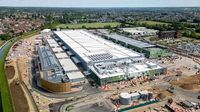The United Kingdom is on the cusp of a dramatic transformation in its digital landscape, as the country gears up for an unprecedented surge in data centre construction. This expansion, driven by the relentless growth of artificial intelligence (AI) and cloud computing, is set to reshape not just the nation’s technology sector, but also its energy and environmental policies, according to recent analyses by Barbour ABI and reports from BBC News and Daily Business Group.
Currently, the UK boasts 477 operational data centres, but that number is projected to swell by nearly a fifth within the next five years. Close to 100 new facilities are in the planning pipeline, with the majority scheduled for completion by 2030. This expansion will reinforce the UK’s standing as the world’s third-largest data centre market, trailing only the United States and Germany.
The epicenter of this construction boom is London and its neighboring counties, where more than half of the new data centres will rise. Wales is set to host nine new sites, Greater Manchester five, and Scotland one, at the former Ravenscraig steelworks in Strathclyde. Other regions across the UK will also see a handful of new facilities, spreading the digital infrastructure more evenly across the nation.
Major US technology giants and investment firms are at the forefront of funding these colossal projects. The Blackstone Group, an American private investment powerhouse, is planning the largest single development: a £10 billion (US$13.6 billion) AI data centre in Blyth, near Newcastle. The project, slated to begin construction in 2031 and span over three years, will feature ten massive buildings covering 540,000 square metres—the equivalent of several large shopping centres—on the site of the former Blyth Power Station.
Microsoft is making its own mark with a £330 million (US$447.3 million) investment in four new UK data centres: two near Leeds, one near Newport in Wales, and a five-storey facility in Acton, northwest London. These are expected to be completed between 2027 and 2029. Meanwhile, Google is constructing two data centres in northeast London, worth £450 million (US$610 million) and spanning 400,000 square metres in the Lee Valley water system area.
According to Barbour ABI’s Megan Pounds, the driving force behind this surge is clear: “As AI becomes an undeniable integration in our everyday lives, it’s also a major factor in driving the surge of data centre construction projects in the UK. The UK’s digital infrastructure is relying on more data centres to be built to store and manage data.”
Yet, while the promise of cutting-edge technology and economic growth is enticing, the rapid expansion of data centres brings with it serious challenges—chief among them, energy and water consumption. The UK government has designated data centres as critical national infrastructure, recognizing their essential role in supporting AI development and digital services. But, as Dr. Sasha Luccioni, AI and Climate Lead at Hugging Face, cautions, the cost of powering these facilities may not be borne solely by the companies that profit from them. “Average citizens in places like Ohio are seeing their monthly bills go up by £15 (US$20) because of data centres,” she told BBC News, adding that the UK’s rollout schedule is “aggressive” and calling for mechanisms to ensure companies, not consumers, shoulder the extra energy costs.
The scale of the anticipated demand is staggering. The National Energy System Operator projects that the growth in UK data centres could add 71 TWh of electricity demand over the next 25 years. This surge in consumption intensifies the need for clean power sources, such as offshore wind—a sector where the UK has already made significant investments. However, high energy costs and lengthy planning processes have prompted some operators to consider building facilities elsewhere, as Bruce Owen, regional president of data centre operator Equinix, explained: “If I want to build a new data centre here within the UK, we’re talking five to seven years before I even have planning permission or access to power in order to do that. So you’re starting to see some of these AI workloads move into other countries, where the UK has always been a very important hub.”
Water usage is another pressing concern. Many data centres rely on water-intensive cooling systems to prevent overheating, and operators often do not disclose how much water they consume. Steve Hone, CEO of The Data Centre Alliance, acknowledges the industry’s limitations: “Ensuring there is enough water and electricity powering data centres isn’t something the industry can solve on its own,” though he insists operators are “fixated with becoming as sustainable as possible,” pointing to innovations like dry cooling.
Despite these efforts, environmental objections have already slowed some projects. In Potters Bar, Hertfordshire, local residents are fighting a £3.8 billion (US$5.2 billion) AI and cloud facility planned on greenbelt land, which they describe as the “lungs” of their community. Across the Irish Sea, Dublin has imposed a moratorium on new data centres after existing ones consumed one fifth of Ireland’s electricity in 2023. Back in the UK, Anglian Water has raised concerns about the strain on water supply from a proposed 435-acre data centre site in North Lincolnshire, though developers have promised to use “closed loop” cooling systems to mitigate the impact.
To address these mounting challenges, the UK government has established an AI Energy Council, tasked with coordinating energy supply and demand for the sector. In addition, £104 billion (US$141 billion) has been earmarked for water infrastructure investment, including the construction of ten new reservoirs in Lincolnshire, the West Midlands, and southeast England. Water UK, the trade body for all water firms, has expressed a strong desire to supply the new centres, but insists that “planning hurdles” must be cleared more quickly to keep pace with demand.
The political stakes are high. Prime Minister Keir Starmer has made the growth of the AI and data centre sector a central plank of his economic strategy. “Artificial Intelligence will drive incredible change in our country. From teachers personalising lessons, to supporting small businesses with their record-keeping, to speeding up planning applications, it has the potential to transform the lives of working people,” Starmer said in a recent statement. “But the AI industry needs a government that is on their side, one that won’t sit back and let opportunities slip through its fingers. And in a world of fierce competition, we cannot stand by. We must move fast and take action to win the global race. Our plan will make Britain the world leader. It will give the industry the foundation it needs and will turbocharge the Plan for Change. That means more jobs and investment in the UK, more money in people’s pockets and transformed public services.”
Deputy Prime Minister Angela Rayner has even overturned some local council rejections of data centre planning permissions, citing their importance to the nation’s infrastructure and the government’s growth agenda.
As the UK races to build the backbone of its digital future, the balancing act between economic ambition, technological progress, and environmental sustainability has never been more delicate—or more decisive for the country’s next chapter.






